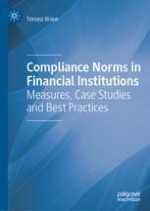2019 | OriginalPaper | Buchkapitel
3. Compliance in Financial Institutions: Tasks, Functions and Structure
verfasst von : Tomasz Braun
Erschienen in: Compliance Norms in Financial Institutions
Aktivieren Sie unsere intelligente Suche, um passende Fachinhalte oder Patente zu finden.
Wählen Sie Textabschnitte aus um mit Künstlicher Intelligenz passenden Patente zu finden. powered by
Markieren Sie Textabschnitte, um KI-gestützt weitere passende Inhalte zu finden. powered by
